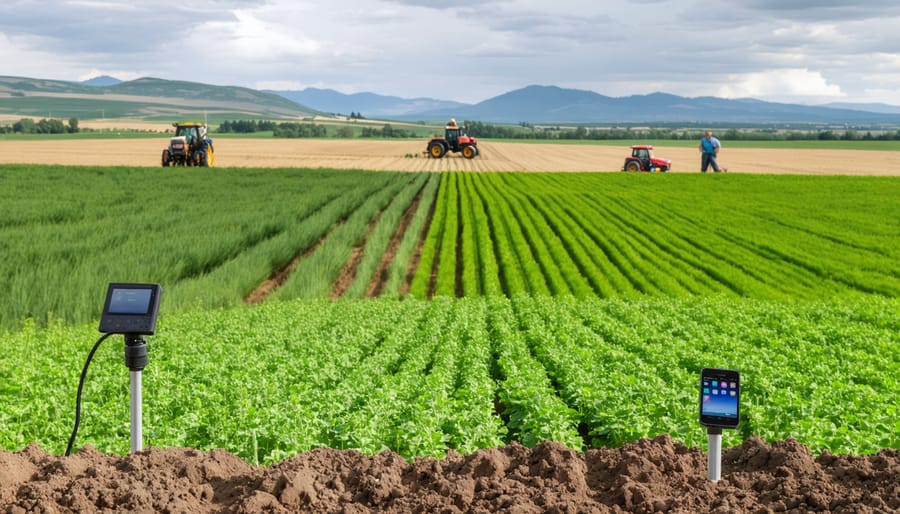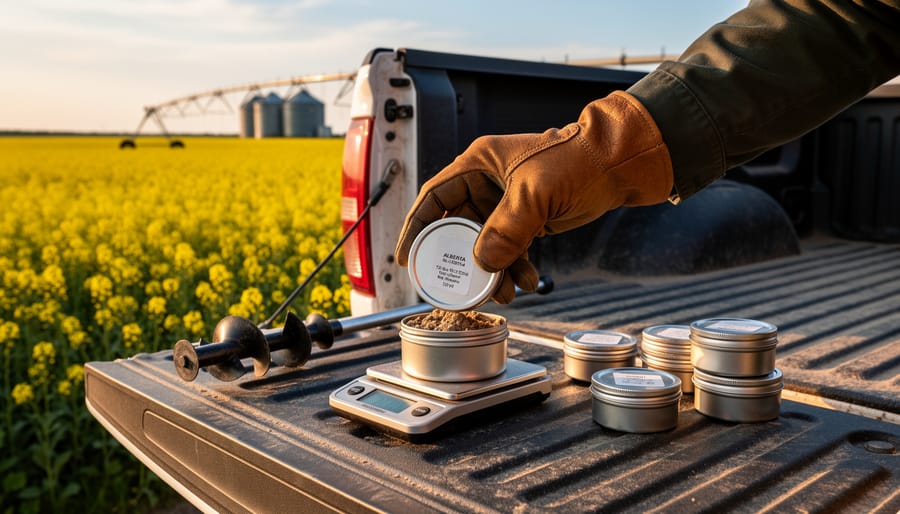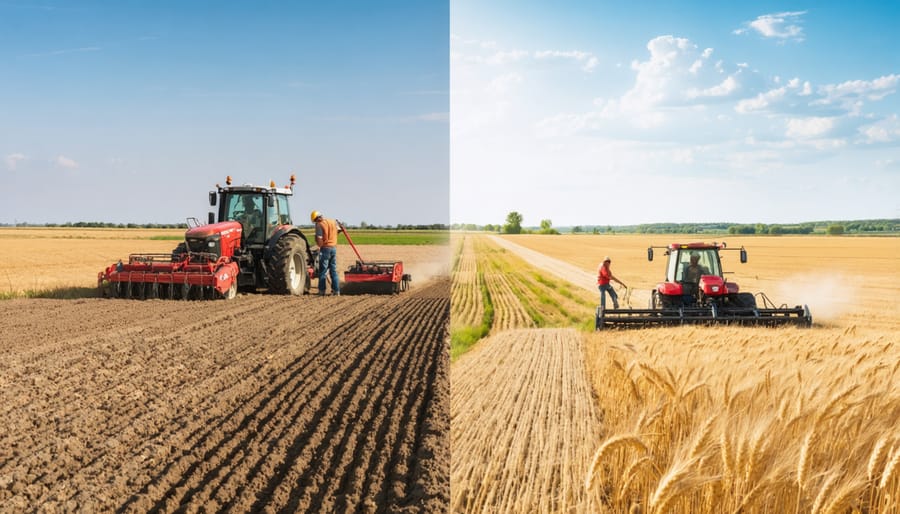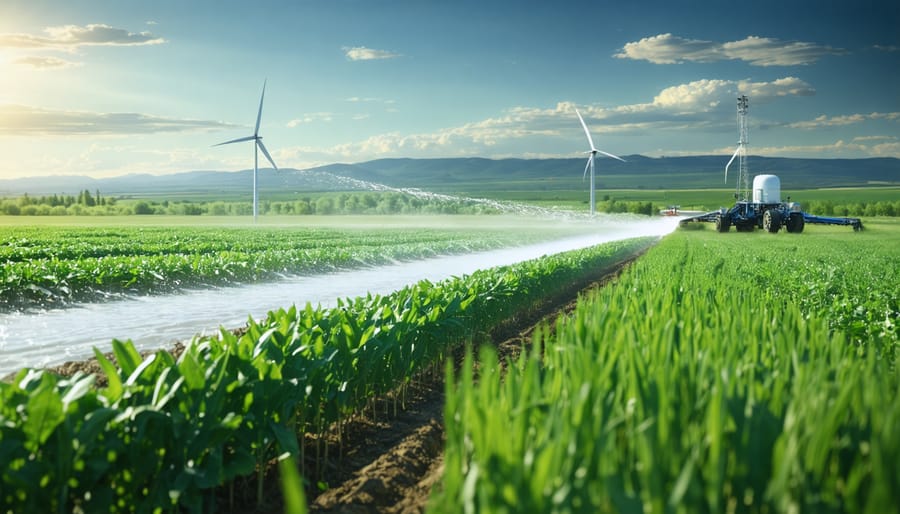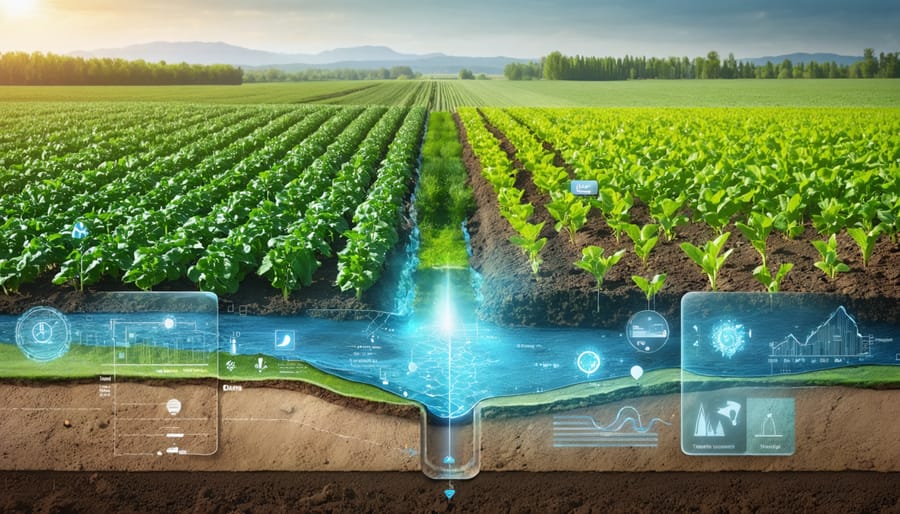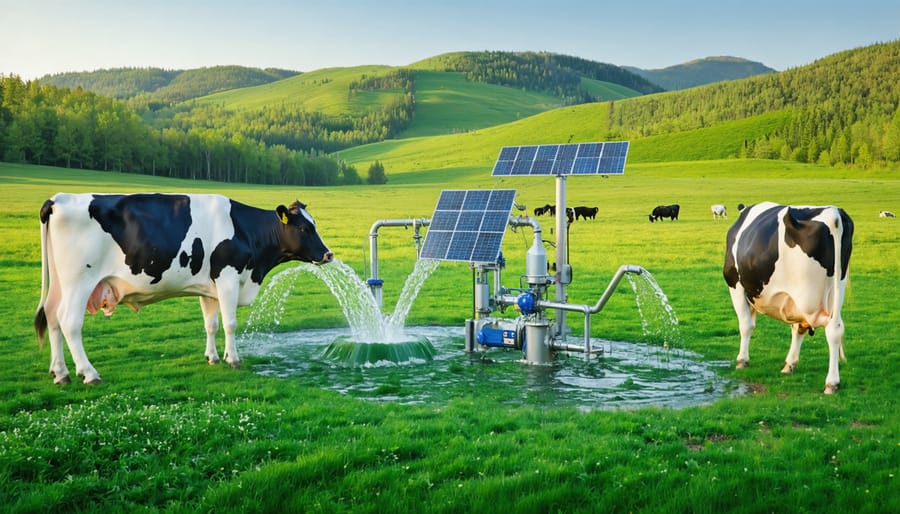Transform your farm’s productivity with precision soil moisture monitoring – technology that’s revolutionizing Alberta’s agricultural landscape. Modern soil moisture sensors deliver real-time data straight to your smartphone, helping you save up to 30% on irrigation costs while maximizing crop yields across diverse soil conditions.
For Alberta farmers battling unpredictable weather patterns and rising operational costs, these sensors serve as underground sentinels, providing crucial insights that traditional methods miss. Whether you’re managing canola in Peace Country’s clay-rich soils or irrigating wheat in Southern Alberta’s semi-arid conditions, accurate moisture data empowers you to make decisions that protect both your crops and bottom line.
Leading agricultural operations across the province have already documented 15-25% increases in water efficiency after implementing sensor networks. By combining moisture readings with local weather data and crop-specific thresholds, these systems help you optimize irrigation scheduling, reduce fertilizer runoff, and maintain ideal growing conditions throughout the season. The result? Healthier crops, reduced input costs, and a more sustainable approach to modern farming.
This practical guide will walk you through selecting, installing, and maximizing the benefits of soil moisture sensors specifically for Alberta’s unique growing conditions.
Why Alberta Farmers Need Advanced Soil Moisture Monitoring
Local Climate Challenges
Alberta farmers face unique challenges when managing soil moisture due to the province’s distinct weather patterns. Alberta’s climate challenges include dramatic temperature fluctuations, unpredictable rainfall patterns, and frequent drought conditions, particularly in the southern regions.
Our growing season typically experiences extended dry periods followed by intense rainfall events, making precise moisture management crucial for crop success. Spring conditions often bring dry winds that can quickly deplete surface moisture, while summer can deliver anything from prolonged dry spells to sudden heavy downpours that risk soil erosion.
The chinook winds, unique to our region, can cause rapid snow melt and moisture loss during winter months, affecting soil moisture reserves for spring planting. These conditions, combined with varying soil types across the province – from heavy clay in the north to sandy loam in the south – create complex moisture management scenarios that require careful monitoring and response.
Understanding these local patterns is essential for implementing effective soil moisture sensor systems that can help farmers make timely irrigation decisions and optimize water use efficiency.
The Cost of Poor Moisture Management
Poor moisture management can significantly impact both crop yields and your bottom line. Here in Alberta, we’ve seen farmers lose up to 30% of their potential yield due to inadequate moisture monitoring, translating to thousands of dollars in lost revenue per growing season.
Beyond crop losses, inefficient irrigation practices can lead to substantially higher water bills. Many farmers report spending 40% more on irrigation than necessary when relying on visual inspection or outdated monitoring methods. For a mid-sized farm of 500 hectares, this could mean an extra $15,000 to $20,000 in unnecessary water costs annually.
The impact extends beyond immediate financial losses. Improper moisture levels can lead to soil degradation, reduced nutrient uptake, and increased susceptibility to disease and pests. We’ve observed cases where farms required several growing seasons to recover from the long-term effects of poor moisture management.
As Tom Anderson, a third-generation farmer from Lethbridge, notes, “Before installing moisture sensors, I was essentially guessing. The cost of that guesswork was far greater than the investment in proper monitoring equipment.”
Modern Soil Moisture Sensor Technologies
Types of Sensors for Different Soil Conditions
Alberta’s diverse soil conditions require careful consideration when selecting moisture sensors. Three main types have proven particularly effective in our prairie landscape: capacitive sensors, tensiometers, and time-domain reflectometry (TDR) sensors.
Capacitive sensors work exceptionally well in our loamy soils, providing reliable readings while being cost-effective for larger operations. These sensors measure the dielectric constant of the soil, offering accurate moisture readings without being significantly affected by soil salinity – a common concern in southern Alberta.
For heavy clay soils prevalent in central Alberta, tensiometers are often the preferred choice. These sensors directly measure soil water tension, providing farmers with precise data about water availability to plant roots. While they require more maintenance, their accuracy in dense soils makes them valuable for implementing effective soil moisture management techniques.
TDR sensors, though more expensive, excel in sandy soils common in eastern Alberta. They offer the most accurate readings across varying soil types and can measure moisture at multiple depths simultaneously. Many producers find their investment worthwhile due to their durability and minimal calibration requirements.
Each sensor type comes with specific installation recommendations based on soil composition, crop type, and field topography. Local agricultural extension offices can provide guidance on the most suitable sensor type for your specific operation.
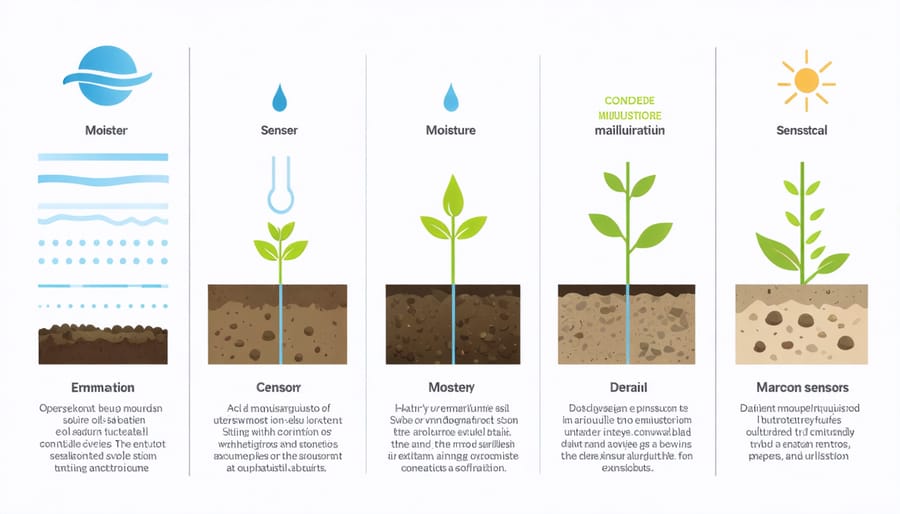

Installation and Maintenance Best Practices
Proper installation and maintenance of water monitoring systems are crucial for achieving reliable soil moisture readings. For optimal results, install sensors at multiple depths – typically 15 cm, 30 cm, and 60 cm – to monitor moisture throughout the root zone. Choose representative locations across your field, avoiding areas with unusual soil composition or topography.
Before installation, calibrate sensors according to manufacturer specifications and your specific soil type. In Alberta’s clay-heavy soils, ensure good soil-to-sensor contact by creating a pilot hole slightly smaller than the sensor diameter. Avoid installing during freezing conditions, as this can damage equipment and create air pockets around sensors.
Maintain your sensors by regularly checking battery levels and cleaning any debris from sensor heads. During spring thaw, inspect for frost damage and recalibrate if necessary. Keep detailed records of sensor locations using GPS coordinates and mark them clearly in the field to prevent equipment damage during cultivation.
For winter storage, remove sensors before deep frost sets in, typically by late October in Alberta. Clean them thoroughly, check for wear, and store in a dry, temperature-controlled environment. Replace protective caps and conduct maintenance checks before spring reinstallation.
Remember to verify readings periodically against manual soil moisture measurements to ensure continued accuracy. Most modern sensors last 3-5 years with proper care, making them a reliable investment for your farm’s water management strategy.
Real Results from Alberta Farms
Success Story: Red Deer Valley Farm
Located just outside of Red Deer, Alberta, the Thompson family’s mixed farming operation has transformed their water management practices through the strategic implementation of soil moisture sensors. In 2019, they installed a network of 12 sensors across their 2,000-hectare farm, focusing primarily on their canola and wheat fields.
Before implementing the sensors, the Thompsons relied on traditional irrigation scheduling and visual assessment of soil conditions. “We were essentially guessing when to irrigate,” explains Sarah Thompson, who manages the farm’s technology systems. “Some fields were getting too much water, while others weren’t getting enough.”
Within the first growing season, the farm reduced its water consumption by 30% while maintaining crop yields. By the second year, they noticed a 15% increase in yield across their canola fields, which they attribute to more precise irrigation timing and better root development.
The system proved particularly valuable during the 2021 drought, when the Thompsons used real-time soil moisture data to optimize their limited water resources. Their crops showed remarkable resilience compared to neighboring farms, with soil moisture sensors helping them maintain optimal moisture levels throughout the growing season.
The farm’s success has inspired other local producers to adopt similar technology. “The initial investment of $15,000 paid for itself within two seasons through water savings and improved yields,” Sarah notes. The Thompsons now host regular field days, sharing their experience with other Alberta farmers interested in implementing soil moisture monitoring systems.
Key to their success was combining the sensor data with local weather forecasts and crop-specific moisture requirements, creating a comprehensive approach to water management that continues to evolve with each growing season.
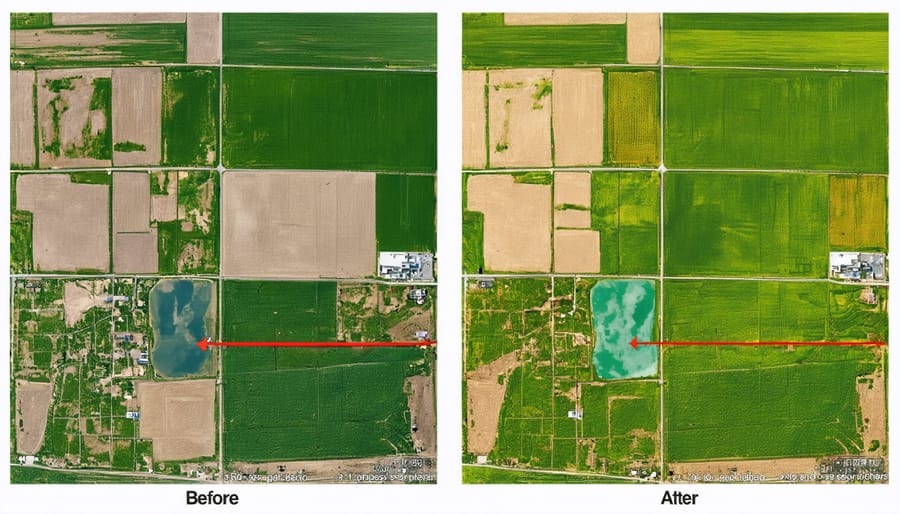
Success Story: Prairie Heights Agricultural
Located just east of Red Deer, Prairie Heights Farm transformed their 2,000-hectare operation by implementing a comprehensive soil moisture monitoring system across their diverse crop rotation of canola, wheat, and pulse crops. Farm owner Sarah McKenzie and her team installed a network of 15 strategically placed sensors in 2021, focusing on areas with varying soil compositions and topography.
The results were remarkable. In their first growing season with the sensors, Prairie Heights reduced irrigation water usage by 28% while maintaining optimal soil moisture levels. This precision approach proved especially valuable during the unexpected dry spell in late June, when the sensor data helped them make crucial irrigation decisions for their developing canola crop.
“The real-time data changed how we approach irrigation completely,” explains McKenzie. “Instead of relying on visual inspection and gut feeling, we now have concrete numbers to base our decisions on. This has been especially helpful in our lower-lying fields where moisture retention varies significantly.”
The farm’s pulse crops, particularly their yellow pea fields, showed a 15% increase in yield compared to previous seasons. McKenzie attributes this success to maintaining consistent moisture levels during critical growing phases, guided by sensor data. The system also helped them optimize their fertilizer application timing by ensuring proper soil moisture conditions.
The investment in soil moisture sensors paid for itself within two growing seasons through water savings, reduced pumping costs, and improved yields. Prairie Heights now serves as a demonstration site for local farmers interested in implementing similar technology, sharing their experiences and data with the agricultural community.
Implementation Guide for Your Farm
Choosing the Right System
Selecting the right soil moisture sensor system depends largely on your farm’s specific needs and characteristics. For smaller operations under 160 hectares, a portable handheld sensor system might be the most cost-effective solution, allowing you to take periodic readings across different field sections. These systems typically cost between $500-1,500 and work well for diverse crop rotations.
Medium-sized farms (160-650 hectares) often benefit from a network of fixed sensors strategically placed throughout their fields. Consider installing one sensor station per 40 hectares, focusing on areas with different soil types or topography. For wheat and canola operations, which are common in Alberta, look for sensors that measure moisture at multiple depths – typically 10, 20, and 30 centimetres.
Large-scale operations over 650 hectares should consider comprehensive systems that integrate with existing farm management software. These setups usually combine fixed sensors with satellite data and weather stations, providing real-time moisture data across vast areas. While the initial investment might range from $15,000-30,000, the potential water savings and yield improvements often justify the cost.
For specialty crops like potatoes or sugar beets, which are moisture-sensitive, opt for high-precision sensors with accuracy within 2% moisture content. Root crops typically need sensors capable of reading moisture levels at shallower depths, while deeper-rooted crops like alfalfa benefit from sensors that can measure up to 1 metre deep.
Cost Analysis and ROI Timeline
Initial investment in soil moisture sensors typically ranges from $200 to $1,500 per unit, depending on the technology level and monitoring capabilities. For a 160-acre field (quarter section), farmers usually need 3-5 sensors strategically placed, bringing the total hardware investment to $600-$7,500. Annual maintenance and data subscription costs average $150-$300 per sensor.
However, these costs are often offset within 1-2 growing seasons through improved irrigation efficiency and yield increases. Alberta farmers implementing moisture sensors report water savings of 15-30% and yield improvements of 8-15%, depending on crop type and weather conditions. To maximize ROI from water conservation, combine sensors with proper placement and regular calibration.
A case study from Lethbridge County showed that a $5,000 investment in a comprehensive soil moisture monitoring system paid for itself within 8 months through reduced irrigation costs and a 12% increase in canola yields. The five-year ROI averaged 225%, with additional benefits including reduced fertilizer leaching and improved soil health.
Government incentives and environmental farm plan grants can cover up to 30% of the initial investment, making the technology more accessible to small and medium-sized operations. When factoring in long-term benefits and current rebate programs, most farms see complete cost recovery within 12-18 months of implementation.
As we’ve explored throughout this article, soil moisture sensors represent a pivotal investment in modern Canadian agriculture, offering substantial benefits for farms of all sizes across Alberta. By implementing these monitoring systems, farmers can reduce water usage by 20-30%, optimize irrigation scheduling, and make data-driven decisions that protect both crops and soil health.
The evidence is clear: producers using moisture sensors consistently report improved yield quality, reduced input costs, and better drought resilience. These advantages become particularly valuable as we face increasingly variable weather patterns across the prairies.
Taking the first step toward implementing moisture monitoring doesn’t have to be overwhelming. Start small with a pilot project in one field, and gradually expand based on your experience and comfort level. Local agricultural extension offices and equipment suppliers are ready to help you select and install the right system for your operation.
Remember that you’re not alone in this journey. Join the growing community of tech-savvy Canadian farmers who are embracing precision agriculture. Connect with neighboring producers who’ve already implemented these systems, and share experiences through local agricultural associations.
The time to act is now. Whether you’re managing canola in Peace Country or growing wheat in Southern Alberta, soil moisture sensors can help you farm smarter, not harder. Make this season the one where you take control of your soil moisture management and set your operation up for sustainable success.

